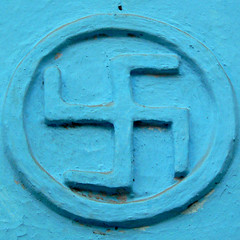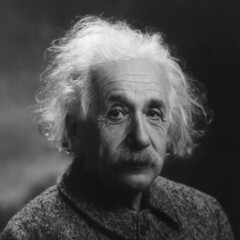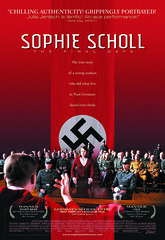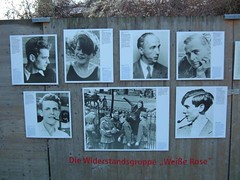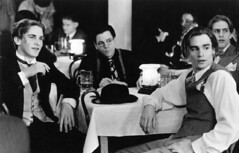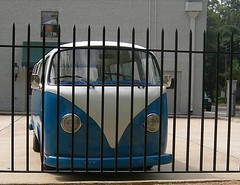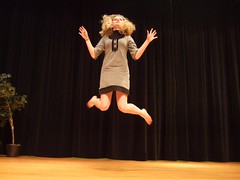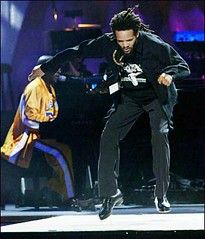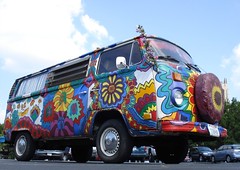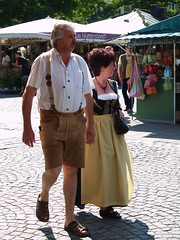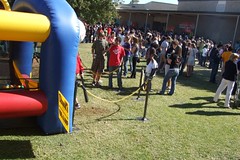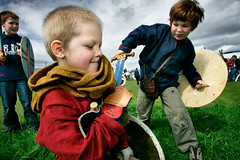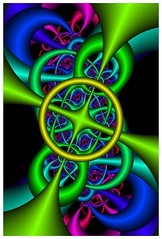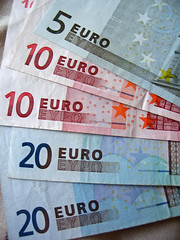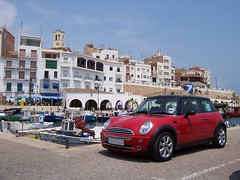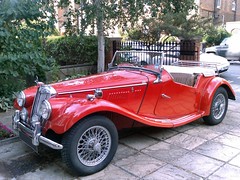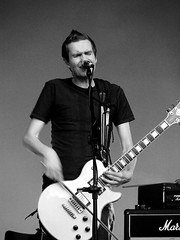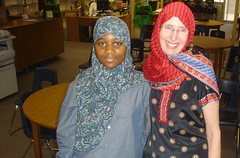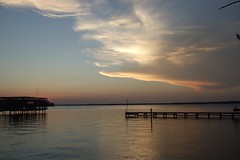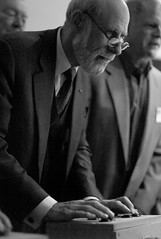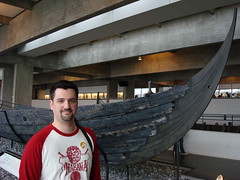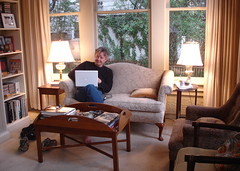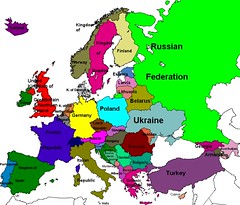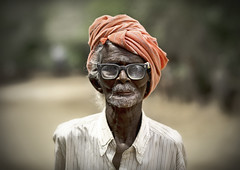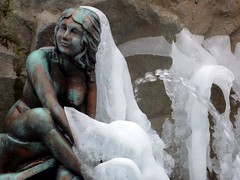Swing Kids review / Trudeau
1. This movie is set in the city of a) Hamburg b) Munich c) Berlin d) Amsterdam.
2. The movie takes place some 6 years after Hitler took power as Chancellor, or a) 1933 b) 1939 c) 1941.
3. The American music and slang treasured by the swing kids originates mostly in
a) Brooklyn b) Harlem c) the Bronx d) Lower East Side.
4. German swing kids favored a clothing style reflective of __ style. a) American
b) British c) Dutch d) German.
5. In the 1930’s there was a new style in jazz groups: a) small combos b) big horn sections c) an electric guitar alongside the bass.
6. Hitler’s regime is referred to as the a) Blitz b) Reich c) Rotterdam d) Seig.
7. In the 1930's German authorities have banned American __ if they were created by Negroes or Jews. a) books b) records c) art d) all the above.
8. Peter Muller has lost his father through Nazi imprisonment. Was the father Jewish? Y / N
9. The father of Thomas Berger, a physician, is taken away by authorities; basically he would be accused of a) protecting Jews b) avoiding military service c) treason d) favoring the Communists.
10. Thomas Berger informs the SS about people not loyal to the Nazis. He is thus a valued member of the a) Swing kids b) Hitler Youth c) University students d) Nazi party.
11. Arvid is a jazz guitarist who is reminsicent of the Belgian gypsy guitar player named a) Benny Goodman b) Gene Krupa c) Django Reinhardt d) Duke Ellington.
12. Peter Muller is disappointed in his mother for her response to the Nazis. Her attitude is one of a) defiance b) compliance c) despair d) neutrality.
13. The smooth, seemingly helpful Herr Knopp is a member of the Nazi secret police, or the a) Panzers b) Blitzkrieg c) Gestapo d) SS, or Schutzstaffel.
14. Peter works as a delivery boy for Herr Schumler. “Herr” means a) store owner b) Mr. c) Professor.
15. In the jazz world a blindfold quiz is one in which you must name the a) musicians b) lyrics c) feeling that you get when you hear the record.
16. Jazz was born about 1900 in the city of a) Chicago b) New Orleans c) NYC.
17. Name a jazz composer who was also a pianist: a) Duke Ellington b) Louis Armstrong c) Antonio Vivaldi d) Cab Calloway.
18. Exercise and athletic competition in the German mountainside as well as bonuses like a motorbike were strategies used by the a) universities b) Hitler Youth c) jazz clubs d) Communists.
19. The Nazis were effective at building a type of super-patriotism. To convince the youth of the Nazi point of view they used exaggeration and fabrications. This is called a) propaganda b) advertising c) nationalism d) enthusiasm.
20. The National Socialist German Worker’s Party, the Nazis, was not at all a) socialist b) German c) national d) a party.
21. Hitler demanded a cheap auto design from a) Mercedes b) Porsche c) Audi d) BMW.
22. A former swing kid named Emil says "I just wised up." He meant that he joined the HJ, Hitler Jugend, to a) disguise his rebellion against the authorities b) have a better life through cooperation with the authorities.
23. "We just play along. We get whatever we want." This form of complicity with the Nazis was the theme of a) Peter Muller b) Thomas Berger c) Arvid Hitmann d) Mrs. Muller.
24. "You think that just because you're not murdering people yourself that you're not part of it? Well, I refuse to do my part." a) Peter Muller b) Thomas Berger c) Arvid Hitmann d) Mrs. Muller.
25. "You've got to go along; make the best of things. We're not in charge. We can't really know what's going on." a) Peter Muller b) Thomas Berger c) Arvid Hitmann d) Mrs. Muller.
26. "Outside the doors of sensible Germans all they hear is Hitler's voice of hate." a) Peter Muller b) Thomas Berger c) Arvid Hitmann d) Mr. Muller, Peter's father.
27. The word for Jew in the German language, or Deutsch: a) Yehudi b) Ebreo c) Juif d) Juden.
28. Following the Holocaust of the 1940's, many of the surviving European Jews migrated to a) Palestine b) Judaea c) Israel d) Syria.
Sunday, November 30, 2008
Friday, November 21, 2008
Nazi Germany (CE 1943) map needed for quiz after holidays
During the war German armies occupied most of Europe; Nazi forces defeated France, took Norway, invaded Yugoslavia and Greece, and occupied much of the European portion of the Soviet Union. Germany also forged alliances with Hungary, Romania, Bulgaria, and later Finland he invaded, as well as collaborators in several other nations. The German defeat at the Battle of Stalingrad in 1942 turned the tide of the war against Germany.
Controlled by Germany following 1939:
Austria, Czechoslovakia, Poland, Ukraine, Baltic nations (Estonia, Latvia, Lithuania), Finald, Norway, Denmark, Netherlands, belgium, France, Romania, Hungary, Yugoslavia, Greece. Also, Northern Africa: Morocco, Algeria, Libya, part of Egypt.
Controlled by Germany following 1939:
Austria, Czechoslovakia, Poland, Ukraine, Baltic nations (Estonia, Latvia, Lithuania), Finald, Norway, Denmark, Netherlands, belgium, France, Romania, Hungary, Yugoslavia, Greece. Also, Northern Africa: Morocco, Algeria, Libya, part of Egypt.
The Swastika is an ancient symbol for good fortune in Buddhist, Hindu and Native American cultures
The word swastika is derived from the Sanskrit word svastik, meaning any lucky or auspicious object, and in particular a mark made on persons and things to denote good luck, says Wikipedia. It has been used for centuries in India as a Hindu symbol and in China, as a Buddhist symbol for good fortune.
Thursday, November 20, 2008
Indie work: please submit it via Google.docs
Rather than worry about storing your papers on your computer's hard drive or on flash drive I recommend using Google.docs.
In fact, for indie work I'm going to require that they be submitted on Google.docs.
1. The papers on Google are accessible to you - for editing or reference - wherever you find yourself.
2. The Google site becomes a digital portfolio.
3. Your teacher is aided by having all papers in one location.
4. Neither you nor your teacher will be able to misplace your papers.
Write it or copy it to your Google account and hit Share. Insert my email - trudeau11@gmail.com - and a notification will be sent to me. I can view it, write remarks and give you a score - from any location.
If you have any trouble with putting papers or visual presentations on Google, email a classmate or me for help. It's easy once you are used to it.
And let's go over the comparison essay checklist while we're discussing indie work:
- Snaffy title and explanatory subtitle.
- Colorful opening sentence.
- Blend topics sentence for sentence. Thoroughly integrate the two stories.
- Documentation: use "according to" at the end of the first paragraph.
- Offer details - facts - instead of generalities.
- Do not worry about a clever closing.
- Proofread (GoogleDocs gives you auto spell check - use it) for grammar and awkward sentences.
In fact, for indie work I'm going to require that they be submitted on Google.docs.
1. The papers on Google are accessible to you - for editing or reference - wherever you find yourself.
2. The Google site becomes a digital portfolio.
3. Your teacher is aided by having all papers in one location.
4. Neither you nor your teacher will be able to misplace your papers.
Write it or copy it to your Google account and hit Share. Insert my email - trudeau11@gmail.com - and a notification will be sent to me. I can view it, write remarks and give you a score - from any location.
If you have any trouble with putting papers or visual presentations on Google, email a classmate or me for help. It's easy once you are used to it.
And let's go over the comparison essay checklist while we're discussing indie work:
- Snaffy title and explanatory subtitle.
- Colorful opening sentence.
- Blend topics sentence for sentence. Thoroughly integrate the two stories.
- Documentation: use "according to" at the end of the first paragraph.
- Offer details - facts - instead of generalities.
- Do not worry about a clever closing.
- Proofread (GoogleDocs gives you auto spell check - use it) for grammar and awkward sentences.
Albert Einstein, a German Jew who touched the world and who left Germany when Hitler arrived
In January 1933, Adolf Hitler was appointed Chancellor of Germany. One of the first actions of Hitler's administration was the Law for the Restoration of the Professional Civil Service, which removed Jews and politically suspect government employees (including university professors) from their jobs. In response to this growing threat Einstein had prudently traveled to the U.S. in December 1932. For several years he had been wintering at the California Institute of Technology in Pasadena, California,[79] and also was a guest lecturer at Abraham Flexner's newly founded Institute for Advanced Study in Princeton, New Jersey.[80]
He was a German-born theoretical physicist. He is best known for his theory of relativity and specifically mass–energy equivalence, expressed by the equation E = mc2. Einstein received the 1921 Nobel Prize in Physics.
The Einsteins bought a house in Princeton (where Elsa died in 1936), and Einstein remained an integral contributor to the Institute for Advanced Study until his death in 1955.
During the 1930s and into World War II, Einstein wrote affidavits recommending United States visas for a huge number of European Jews who were trying to flee persecution.
He was a German-born theoretical physicist. He is best known for his theory of relativity and specifically mass–energy equivalence, expressed by the equation E = mc2. Einstein received the 1921 Nobel Prize in Physics.
The Einsteins bought a house in Princeton (where Elsa died in 1936), and Einstein remained an integral contributor to the Institute for Advanced Study until his death in 1955.
During the 1930s and into World War II, Einstein wrote affidavits recommending United States visas for a huge number of European Jews who were trying to flee persecution.
Sophie Scholl - The Final Days, a movie based on a heroic group of young Germans and their resistance to the Nazi regime
Munich, 1943. As Hitler continues to wage war across Europe, a group of college students mount an underground resistance movement in Munich. Dedicated expressly to the downfall of the monolithic Third Reich war machine, they call themselves the White Rose, says Flickr.com.
One of its few female members, Sophie Scholl, is captured during a dangerous mission to distribute pamphlets on campus with her brother Hans. Unwavering in her convictions and loyalty to the White Rose, her cross-examination by the Gestapo quickly escalates into a searing test of wills as Scholl delivers a passionate call to freedom and personal responsibility that is both haunting and timeless.
In February 2005, a movie about Sophie Scholl's last days, Sophie Scholl – Die letzten Tage (Sophie Scholl: The Final Days), featuring actress Julia Jentsch as Sophie, was released, says Wikipedia. Drawing on interviews with survivors and transcripts that had remained hidden in East German archives until 1990, it was nominated for an Academy Award for Best Foreign Language Film in January 2006.
One of its few female members, Sophie Scholl, is captured during a dangerous mission to distribute pamphlets on campus with her brother Hans. Unwavering in her convictions and loyalty to the White Rose, her cross-examination by the Gestapo quickly escalates into a searing test of wills as Scholl delivers a passionate call to freedom and personal responsibility that is both haunting and timeless.
In February 2005, a movie about Sophie Scholl's last days, Sophie Scholl – Die letzten Tage (Sophie Scholl: The Final Days), featuring actress Julia Jentsch as Sophie, was released, says Wikipedia. Drawing on interviews with survivors and transcripts that had remained hidden in East German archives until 1990, it was nominated for an Academy Award for Best Foreign Language Film in January 2006.
Wednesday, November 19, 2008
The White Rose, a stunning story of German student resistance to the Nazis
The White Rose was a non-violent resistance group in Nazi Germany, consisting of a number of students from the University of Munich and their philosophy professor, says Wikipedia. The group became known for an anonymous leaflet campaign, lasting from June 1942 until February 1943, that called for active opposition to German dictator Adolf Hitler's regime.
The six core members of the group were arrested by the Gestapo, convicted and executed by beheading in 1943. The text of their sixth leaflet was smuggled out of Germany through Scandinavia to the UK, and in July 1943 copies of it were dropped over Germany by Allied planes, retitled "The Manifesto of the Students of Munich."[1]
Today, the members of the White Rose are honoured in Germany as some of its greatest heroes because they opposed the Third Reich in the face of almost certain death.
In February 2005, a movie about conspirator Sophie Scholl's last days, Sophie Scholl – Die letzten Tage (Sophie Scholl: The Final Days), featuring actress Julia Jentsch as Sophie, was released. Drawing on interviews with survivors and transcripts that had remained hidden in East German archives until 1990, it was nominated for an Academy Award for Best Foreign Language Film in January 2006.
The six core members of the group were arrested by the Gestapo, convicted and executed by beheading in 1943. The text of their sixth leaflet was smuggled out of Germany through Scandinavia to the UK, and in July 1943 copies of it were dropped over Germany by Allied planes, retitled "The Manifesto of the Students of Munich."[1]
Today, the members of the White Rose are honoured in Germany as some of its greatest heroes because they opposed the Third Reich in the face of almost certain death.
In February 2005, a movie about conspirator Sophie Scholl's last days, Sophie Scholl – Die letzten Tage (Sophie Scholl: The Final Days), featuring actress Julia Jentsch as Sophie, was released. Drawing on interviews with survivors and transcripts that had remained hidden in East German archives until 1990, it was nominated for an Academy Award for Best Foreign Language Film in January 2006.
Thomas Berger to his father, the wealthy professional: "Is that why you voted for him?" referring to Hitler
The wealthy class of Germany voted for the Nazis in 1932 so as to avoid a worse political alternative, the Socialists. Fearful that the Socialists would limit their comfortable lives, the upper class Germans chose Hitler. Their hope was that he would not act too rashly and that, if he tried to enact radical programs, the German army would hold the line against him.
Sadly, Hitler was canny as well as lucky in politics. In 1933 he managed to be named Chncellor of the nation. From that point he leveraged greater control and - through the brutal, murderous Gestapo - enacted his extreme ethnocentric plan.
Hitler quickly silenced people critical of his regime. Peter Muller's father was sent to prison because he defended Jewish professors who had been expelled from their teaching positions.
The racist spirit of the German people was unleashed and encouraged. The government began a systematic program of identifying and exterminating Jews. Also marked and sent to slave labor camps and death camps: Gypsies, Poles, Czechs, gays, etc.
At that point the Germans who realized that Hitler's program was wrong, deeply wrong, were unable to effectively protest. Many Germans went along with Hitler's programs even though they did not believe in them. The Hiler Jugend leader called Emil says "I just wised up." He simply wanted to survive the reign of terror.
Sadly, Hitler was canny as well as lucky in politics. In 1933 he managed to be named Chncellor of the nation. From that point he leveraged greater control and - through the brutal, murderous Gestapo - enacted his extreme ethnocentric plan.
Hitler quickly silenced people critical of his regime. Peter Muller's father was sent to prison because he defended Jewish professors who had been expelled from their teaching positions.
The racist spirit of the German people was unleashed and encouraged. The government began a systematic program of identifying and exterminating Jews. Also marked and sent to slave labor camps and death camps: Gypsies, Poles, Czechs, gays, etc.
At that point the Germans who realized that Hitler's program was wrong, deeply wrong, were unable to effectively protest. Many Germans went along with Hitler's programs even though they did not believe in them. The Hiler Jugend leader called Emil says "I just wised up." He simply wanted to survive the reign of terror.
Tuesday, November 18, 2008
Notes on German life from Swing Kids
American jazz greats mentioned in Swing Kids . . .
a) Count Basie - pianist and band leader; one of the kings of swing.
b) Artie Shaw - clarinetist and band leader; he signed Billie Holiday as his band's vocalist in 1938, becoming the first white bandleader to hire a full-time black female singer.
c) Duke Ellington - composer, pianist, and bandleader recognized during his life as one of the most influential figures in jazz. Ellington delivered some huge hits during the 1930s: Mood Indigo in 1930, It Don't Mean a Thing (If It Ain't Got That Swing) in 1932, Sophisticated Lady in 1933, In a Sentimental Mood in 1935, Caravan in 1937, I Let A Song Go Out Of My Heart in 1938. Following shortly were Do Nothing Till You Hear from Me in 1940 and Take the "A" Train (written by Billy Strayhorn) in 1941.
d) Django Rheinhardt - Belgian Gypsy jazz guitarist who won fame in the US for his Paris recordings with Quintette du Hot Club de France.
e) Gene Krupa - influential American jazz and big band drummer, known for his highly energetic and flamboyant style.
Pejoratives (insults)
- kike: Jewish person.
- heine: Jewish person.
heil: "hail."
scheiss: excrement
verboten: "forbidden"
achtung: "Watch out"
- A clubfoot is a birth defect. Without treatment, persons afflicted often appear to walk on their ankles, or on the sides of their feet. It is a common birth defect, occurring in about one in every 1,000 live births, says Wikipedia.
Indie work choices this week:
- Research and compare the achievements of Adi Dassler and JS Bach.
- " and " the impact of Bayer Aspirin and the Volkswagen companies.
a) Count Basie - pianist and band leader; one of the kings of swing.
b) Artie Shaw - clarinetist and band leader; he signed Billie Holiday as his band's vocalist in 1938, becoming the first white bandleader to hire a full-time black female singer.
c) Duke Ellington - composer, pianist, and bandleader recognized during his life as one of the most influential figures in jazz. Ellington delivered some huge hits during the 1930s: Mood Indigo in 1930, It Don't Mean a Thing (If It Ain't Got That Swing) in 1932, Sophisticated Lady in 1933, In a Sentimental Mood in 1935, Caravan in 1937, I Let A Song Go Out Of My Heart in 1938. Following shortly were Do Nothing Till You Hear from Me in 1940 and Take the "A" Train (written by Billy Strayhorn) in 1941.
d) Django Rheinhardt - Belgian Gypsy jazz guitarist who won fame in the US for his Paris recordings with Quintette du Hot Club de France.
e) Gene Krupa - influential American jazz and big band drummer, known for his highly energetic and flamboyant style.
Pejoratives (insults)
- kike: Jewish person.
- heine: Jewish person.
heil: "hail."
scheiss: excrement
verboten: "forbidden"
achtung: "Watch out"
- A clubfoot is a birth defect. Without treatment, persons afflicted often appear to walk on their ankles, or on the sides of their feet. It is a common birth defect, occurring in about one in every 1,000 live births, says Wikipedia.
Indie work choices this week:
- Research and compare the achievements of Adi Dassler and JS Bach.
- " and " the impact of Bayer Aspirin and the Volkswagen companies.
Germany in the 1930's: there were a few young anti-Nazis called Swing Kids
"You must learn to steel yourself." Frau Muller to her son in regards living under Nazi control.
Principal characters in Swing Kids . . .
Peter Muller, the protagonist
Thomas Berger, his buddy
Arvid / Hitmann, the crippled guitarist
Herr Knopp, Gestapo officer
See more at Imdb.com, the Internet Movie Database.
Can you see ways in which your personal struggle for independence is similar to the ways in which these guys tried to react to the Nazis?
- Is there a figure who represents the disappointing capitulation to conformity?
- Is there a character who represents the seductive but diabolical force of conformity?
- Which figure is consumed by fiery rebellion and unswerving opposition to the Nazis?
- Why is the Hitler Jugend, Hitler Youth Organization, so appealing?
- Verrator! Traitor! When a Jew or other anti-Nazi German is identified, they lose their property as well as their freedom. The Nazi party is partly built upon what element of human temptation?
- What themes of life are seen in the jazz music?
Principal characters in Swing Kids . . .
Peter Muller, the protagonist
Thomas Berger, his buddy
Arvid / Hitmann, the crippled guitarist
Herr Knopp, Gestapo officer
See more at Imdb.com, the Internet Movie Database.
Can you see ways in which your personal struggle for independence is similar to the ways in which these guys tried to react to the Nazis?
- Is there a figure who represents the disappointing capitulation to conformity?
- Is there a character who represents the seductive but diabolical force of conformity?
- Which figure is consumed by fiery rebellion and unswerving opposition to the Nazis?
- Why is the Hitler Jugend, Hitler Youth Organization, so appealing?
- Verrator! Traitor! When a Jew or other anti-Nazi German is identified, they lose their property as well as their freedom. The Nazi party is partly built upon what element of human temptation?
- What themes of life are seen in the jazz music?
Monday, November 17, 2008
Jazz and Germany
The movie Swing Kids unfolds in Nazi era Germany and concerns a group of rebellious young Germans who despise Hitler and his Nazi regime.
The map of Germany that you must know -
- Berlin, the capital.
- Munchen (Munich), the regional capital of Bavaria.
- Bavarian Alps.
- Rhine River.
- Frankfurt (an ancient name that meant "the place where the Franks forded the river")
- Koln (Cologne)
- Hamburg, a North Sea port via the Elbe River.
- All nine nations that border Deutschland.
The map of Germany that you must know -
- Berlin, the capital.
- Munchen (Munich), the regional capital of Bavaria.
- Bavarian Alps.
- Rhine River.
- Frankfurt (an ancient name that meant "the place where the Franks forded the river")
- Koln (Cologne)
- Hamburg, a North Sea port via the Elbe River.
- All nine nations that border Deutschland.
Sunday, November 16, 2008
The intersection of American and German cultures in the 1930's: jazz, racism and freedom
In the movie Swing Kids the viewer slips into Germany and the Holocaust through the back door. In the 1930's the world's hottest, most liberating music was American jazz. Much like rock 'n roll in the 1950's, it scared the world's conservatives because it was rebellious and electric.
The Nazi organization tried to ban jazz which at that time was fomenting a vibrant connection between Germany and the US. It was a connection that challenged traditional ethnocentrism / racism and put the emphasis on the art and joy of well-written music.
Swing Kids is an informative introduction to 20th century European culture and the conflicts that bedevil Europeans to this day.
Thus our unit this week will be modern Germany, WWII and the roots of ethnocentrism that resulted in the ethnic devastation called the Holocaust.
Artistically speaking, please check out tap man Savion Glover; he is a modern embodiment of the jazz aesthetic as expressed in dance.
The Nazi organization tried to ban jazz which at that time was fomenting a vibrant connection between Germany and the US. It was a connection that challenged traditional ethnocentrism / racism and put the emphasis on the art and joy of well-written music.
Swing Kids is an informative introduction to 20th century European culture and the conflicts that bedevil Europeans to this day.
Thus our unit this week will be modern Germany, WWII and the roots of ethnocentrism that resulted in the ethnic devastation called the Holocaust.
Artistically speaking, please check out tap man Savion Glover; he is a modern embodiment of the jazz aesthetic as expressed in dance.
Friday, November 14, 2008
Volkswagen MiniBus, an epochal vehicle
Name the nation that is home to . . .
1. Audi
2. Rolls Royce
3. Citroen
4. VW
5. Jaguar
6. BMW
7. Peugeot
8. Cooper / Morris
9. Land Rover
10. Mercedes Benz (Daimler Benz)
11. Porsche
12. Renault
13. MG
14. Volvo
15. Aston Martin
16. Saab
17. Bugatti Veyron
18. Lexus
19. Bentley
20. Lotus
German: 1, 6, 10, 11, 17
UK: 2, 4, 5, 8, 9, 13, 15, 17, 19, 20
France: 3, 7, 12
Sweden: 14, 16
Btw, the principal Japanese car companies include
- Honda / Acura
- Toyota / Lexus
- Mazda
- Suzuki
- Mitsubishi
- Nissan
- Subaru
- Kawasaki
1. Audi
2. Rolls Royce
3. Citroen
4. VW
5. Jaguar
6. BMW
7. Peugeot
8. Cooper / Morris
9. Land Rover
10. Mercedes Benz (Daimler Benz)
11. Porsche
12. Renault
13. MG
14. Volvo
15. Aston Martin
16. Saab
17. Bugatti Veyron
18. Lexus
19. Bentley
20. Lotus
German: 1, 6, 10, 11, 17
UK: 2, 4, 5, 8, 9, 13, 15, 17, 19, 20
France: 3, 7, 12
Sweden: 14, 16
Btw, the principal Japanese car companies include
- Honda / Acura
- Toyota / Lexus
- Mazda
- Suzuki
- Mitsubishi
- Nissan
- Subaru
- Kawasaki
Thursday, November 13, 2008
Lederhosen and dirndl: traditional garb of the Bavarian people
Bavaria, home of the BMW car and motorcycle, is also home to One of the traditional German styles of clothing.
The leather shorts are good for mountain hikers. The vested blouse and full skirt of the dirndl are often portrayed as the garb for marvelous wenches serving ale in giant steins.
The leather shorts are good for mountain hikers. The vested blouse and full skirt of the dirndl are often portrayed as the garb for marvelous wenches serving ale in giant steins.
From Hibernia (the Roman name for Ireland) to Bavaria quiz
1. The Deutsch Mark has been replaced by the
a) Euro b) Franc c) Pound d) USD.
2. The European continent is dominated by a) Asians
b) peninsulas c) Russia d) automobile manufacturers.
3. Bentley and Lotus are high-quality, snob-appeal vehicles manufactured in Germany for the wealthy class not only in Europe, but in Asia and the US as well. T / F
4. Stockholm, Denmark, is a great city of the region called Scandinavia, former home of the Vikings. T / F
5. Iceland is populated with migrants from a) Britain
b) Sweden c) Ireland d) Greenland.
6. A conception of what is artistically valid, beautiful, fresh or graceful: a) aesthetics b) stereotypes c) synergy
d) aegis.
7. For some 200 years the dominant ethnic group of the US was the a) European Catholics b) Norsemen
c) German-Americans d) Anglo-Saxons.
8. The term “United Kingdom” (UK) is a) ethnocentric
b) not ethnocentric c) Eurocentric d) not Eurocentric.
9. The category Protestant includes denominations such as Baptist, Methodist, Presbyterian, Episcopalian and Unitarian. T / F
10. Morocco is included in the category of a European nation because it is separated from the Euros only by the Strait of Gibraltar. T / F
11. Germany is not included in the category of a European nation because it was settled by Celts and Asians. T / F
12. To reach Helsinki, Finland, by ship from London you must pass through the __ Sea and the Baltic Sea. a) Strait of Dover
b) Arctic c) North d) Gulf of Bothnia.
13. What European nation’s capital city lies at 60N, 10E? a) Sweden
b) Norway c) Denmark d) Finland.
14. Which auto company was founded in the Germany’s southern region of Bavaria? a) BMW b) Audi c) Volkswagen d) Mercedes Benz.
15. Which is more populous? a) Germany b) UK c) France d) Spain.
a) Euro b) Franc c) Pound d) USD.
2. The European continent is dominated by a) Asians
b) peninsulas c) Russia d) automobile manufacturers.
3. Bentley and Lotus are high-quality, snob-appeal vehicles manufactured in Germany for the wealthy class not only in Europe, but in Asia and the US as well. T / F
4. Stockholm, Denmark, is a great city of the region called Scandinavia, former home of the Vikings. T / F
5. Iceland is populated with migrants from a) Britain
b) Sweden c) Ireland d) Greenland.
6. A conception of what is artistically valid, beautiful, fresh or graceful: a) aesthetics b) stereotypes c) synergy
d) aegis.
7. For some 200 years the dominant ethnic group of the US was the a) European Catholics b) Norsemen
c) German-Americans d) Anglo-Saxons.
8. The term “United Kingdom” (UK) is a) ethnocentric
b) not ethnocentric c) Eurocentric d) not Eurocentric.
9. The category Protestant includes denominations such as Baptist, Methodist, Presbyterian, Episcopalian and Unitarian. T / F
10. Morocco is included in the category of a European nation because it is separated from the Euros only by the Strait of Gibraltar. T / F
11. Germany is not included in the category of a European nation because it was settled by Celts and Asians. T / F
12. To reach Helsinki, Finland, by ship from London you must pass through the __ Sea and the Baltic Sea. a) Strait of Dover
b) Arctic c) North d) Gulf of Bothnia.
13. What European nation’s capital city lies at 60N, 10E? a) Sweden
b) Norway c) Denmark d) Finland.
14. Which auto company was founded in the Germany’s southern region of Bavaria? a) BMW b) Audi c) Volkswagen d) Mercedes Benz.
15. Which is more populous? a) Germany b) UK c) France d) Spain.
Wednesday, November 12, 2008
Icelanders and their unusual genealogy
Dr. Kari Stefansson can trace his ancestry back 1,100 years. That's almost unheard of in the U.S., but in his native Iceland, where genealogy is a national obsession, it hardly raises an eyebrow, says Time magazine.
The island nation is a genetic anomaly: settled by a few Norsemen and Celts in the 9th century A.D. and relatively free of later immigration, it is among the most genetically homogeneous countries on earth.
And in the late 1990s, when scientists were racing to map the human genome, Stefansson realized that Iceland's genetic isolation and unrivaled genealogical records made it a potential gold mine for isolating genes.
Thus began Iceland's great genetic experiment, an attempt to mine the gene pool of an entire country in search of the root causes of--and potential cures for--some of the world's worst diseases. And after years of controversy, dashed hopes and burst stock bubbles, the effort is finally paying off.
The island nation is a genetic anomaly: settled by a few Norsemen and Celts in the 9th century A.D. and relatively free of later immigration, it is among the most genetically homogeneous countries on earth.
And in the late 1990s, when scientists were racing to map the human genome, Stefansson realized that Iceland's genetic isolation and unrivaled genealogical records made it a potential gold mine for isolating genes.
Thus began Iceland's great genetic experiment, an attempt to mine the gene pool of an entire country in search of the root causes of--and potential cures for--some of the world's worst diseases. And after years of controversy, dashed hopes and burst stock bubbles, the effort is finally paying off.
Living map of Europe Project: you've got one nation to graphically capture
Students will fill their giant sheet of white paper with the large sketch of their nation, following these guidelines:
a) Numerous colors.
b) Printed statistics and factoids.
c) Cities.
d) Rivers and indications of terrain.
e) Large name of the nation.
f) Student name.
g) Names of neighboring nations in small print along the borders of your nation.
Due Friday. 10 pts.
We will do research and prep in class; you will be expected to complete it as home work.
a) Numerous colors.
b) Printed statistics and factoids.
c) Cities.
d) Rivers and indications of terrain.
e) Large name of the nation.
f) Student name.
g) Names of neighboring nations in small print along the borders of your nation.
Due Friday. 10 pts.
We will do research and prep in class; you will be expected to complete it as home work.
Tuesday, November 11, 2008
In the school play, The Outsiders: Jonathan Zvaladriga, Andrew Wood
Geography students may win 3 pts bonus credit by attending the school play, The Outsiders, this Wed, Th or Fri.
Sit in the front rows and give the actors lots of love.
Sit in the front rows and give the actors lots of love.
Inexpensive workshop explores digital fx at LSUS on Sat, Nov 22
In the entertainment arena, computer graphics is constantly growing and evolving. This workshop, says John Miralles, will introduce you to the field of entertainment computer graphics.
The Animation and Visual Effects Institute (AVEI) at LSUS has been founded to educate talented candidates for careers in those fields. Many of these areas of computer graphics use high-end software and techniques that can be exciting and a challenge to learn.
This workshop is intended to introduce a student with little or no prior exposure to the field of entertainment computer graphics. Topics to be covered will include basic digital imaging, using Adobe Photoshop, basic video compositing using HD footage and Adobe AfterEffects. An introduction to 3D Computer generated images will also be demonstrated.
By the end of the workshop, students will have created their first visual effects shot and have a greater understanding of the exciting fields.
For Ages 15 & up
Note: There will be a 1 hour lunch break from 12-1.
Due to popular demand, a second class has been scheduled.
High School Students ~ Pay only $10!! You have to register in person (have a valid Student ID) in the Continuing Education office in the Technology Center.
Call 798-4177.
Miralles says he will offer a similar workshop for the under-15's in January.
The Animation and Visual Effects Institute (AVEI) at LSUS has been founded to educate talented candidates for careers in those fields. Many of these areas of computer graphics use high-end software and techniques that can be exciting and a challenge to learn.
This workshop is intended to introduce a student with little or no prior exposure to the field of entertainment computer graphics. Topics to be covered will include basic digital imaging, using Adobe Photoshop, basic video compositing using HD footage and Adobe AfterEffects. An introduction to 3D Computer generated images will also be demonstrated.
By the end of the workshop, students will have created their first visual effects shot and have a greater understanding of the exciting fields.
For Ages 15 & up
Note: There will be a 1 hour lunch break from 12-1.
Due to popular demand, a second class has been scheduled.
High School Students ~ Pay only $10!! You have to register in person (have a valid Student ID) in the Continuing Education office in the Technology Center.
Call 798-4177.
Miralles says he will offer a similar workshop for the under-15's in January.
Euro map: the entire blintz
Please use your student number - a la geography class - to find the nation that is yours for research and presentation.
1. Portugal
2. Spain
3. France
4. Luxembourg
5. Netherlands
6. Britain
7. Ireland
8. Norway
9. Sweden
10. Finalnd
11. Denmark
12. Germany
13. Switzerland
14. Austria
15. Italy
16. Czech Republic
17. Poland
18. Hungary
19. Romania
20. Croatia
21. Slovenia
22. Yugoslavia
23. Bulgaria
24. Albania
25. Macedonia
26. Greece
27. Bosnia
28. Slovakia
29. Moldova
30. Ukraine
31. Belarus
32/ Lithuania
33. Latvia
34. Estonia
35. Russia
1. Portugal
2. Spain
3. France
4. Luxembourg
5. Netherlands
6. Britain
7. Ireland
8. Norway
9. Sweden
10. Finalnd
11. Denmark
12. Germany
13. Switzerland
14. Austria
15. Italy
16. Czech Republic
17. Poland
18. Hungary
19. Romania
20. Croatia
21. Slovenia
22. Yugoslavia
23. Bulgaria
24. Albania
25. Macedonia
26. Greece
27. Bosnia
28. Slovakia
29. Moldova
30. Ukraine
31. Belarus
32/ Lithuania
33. Latvia
34. Estonia
35. Russia
Western Europe: the Western nations
The next segment of the Euro map.
Quiz on Tues, next week.
1. France
2. Belgium
3. Luxembourg
4. Espana (Spain)
5. Portugal
6. Strait of Gibraltar
7. Monaco
8. Italy / L'Italia
9. Switzerland
10. Austria
11. Mediterranean
12. Rhine River
Quiz on Tues, next week.
1. France
2. Belgium
3. Luxembourg
4. Espana (Spain)
5. Portugal
6. Strait of Gibraltar
7. Monaco
8. Italy / L'Italia
9. Switzerland
10. Austria
11. Mediterranean
12. Rhine River
Monday, November 10, 2008
What are the implications about a country when you find it is the home of numerous auto companies?
Several European nations have distinguished themselves by creation of great motor car companies.
With that success, the implications for these countries would be . . .
- wealthy nations / high standard of living
- education
- global sales / foreign trade
- artistic / creative
- engineering
- emphasis on quality
- capture imaginations
- fabric technology / upholstery
- safety
- energy efficiency
- natural resources
With that success, the implications for these countries would be . . .
- wealthy nations / high standard of living
- education
- global sales / foreign trade
- artistic / creative
- engineering
- emphasis on quality
- capture imaginations
- fabric technology / upholstery
- safety
- energy efficiency
- natural resources
Sunday, November 09, 2008
Sigur Rós and Bjork, 2 pop personalities from Iceland
Sigur Rós are an Icelandic post-rock band with melodic, classical and minimalist elements. The band is known for its ethereal sound and lead singer Jónsi Birgisson's falsetto voice.
Björk Guðmundsdóttir (born 21 November 1965) is an Icelandic singer-songwriter, composer, actress and music producer. She has been nominated for 13 Grammy Awards, an Academy Award and two Golden Globe Awards (including one for acting).
She is best known for her expressive vocals, broad soprano vocal range, and a diverse and eclectic musical style which incorporates influences from many different genres,[2] including pop, alternative rock, jazz, ambient music, electronica, classical and folk, as well as her eccentric costumes. Her singles "It's Oh So Quiet", "Army of Me" and "Hyperballad" all charted in the UK Top 10.
Her record label, One Little Indian, reported in 2003 that she had sold more than 15 million albums worldwide. She was ranked #36 on VH1's "The 100 Greatest Women in Rock and Roll"[4] and #8 on MTV's "22 Greatest Voices in Music".
Björk Guðmundsdóttir (born 21 November 1965) is an Icelandic singer-songwriter, composer, actress and music producer. She has been nominated for 13 Grammy Awards, an Academy Award and two Golden Globe Awards (including one for acting).
She is best known for her expressive vocals, broad soprano vocal range, and a diverse and eclectic musical style which incorporates influences from many different genres,[2] including pop, alternative rock, jazz, ambient music, electronica, classical and folk, as well as her eccentric costumes. Her singles "It's Oh So Quiet", "Army of Me" and "Hyperballad" all charted in the UK Top 10.
Her record label, One Little Indian, reported in 2003 that she had sold more than 15 million albums worldwide. She was ranked #36 on VH1's "The 100 Greatest Women in Rock and Roll"[4] and #8 on MTV's "22 Greatest Voices in Music".
Two long-established French auto companies that are popular in Europe and Asia: Peugeot and Citroen
Peugeot is a major French car brand, part of PSA Peugeot Citroën. It is the second largest automaker in Europe, behind Volkswagen. Peugeot's roots go back to pepper, salt and coffee mill manufacturing in 1842 and later bicycle manufacturing at the end of the 19th century. Its world headquarters are in Paris, says Wikipedia.
Peugeot is also famous for its bicycles, motor scooters, trucks and grand prix racing cars.
Citroën (pronounced See-Troh-Enn) is a French automobile manufacturer, founded in 1919 by André Citroën.
Originally a mass-market car maker with relatively straightforward designs, Citroën shocked the world in 1934 with the innovative Traction Avant, the world's first mass-production front wheel drive car (1934–56).
Significant models include the H Van (1947–81, "HY"), the 2CV (1948–90, "The Duck"), the DS (1955–1975, "Goddess") and the CX (1974–91).
Shown: a new Peugeot convertible at home in Ireland.
Peugeot is also famous for its bicycles, motor scooters, trucks and grand prix racing cars.
Citroën (pronounced See-Troh-Enn) is a French automobile manufacturer, founded in 1919 by André Citroën.
Originally a mass-market car maker with relatively straightforward designs, Citroën shocked the world in 1934 with the innovative Traction Avant, the world's first mass-production front wheel drive car (1934–56).
Significant models include the H Van (1947–81, "HY"), the 2CV (1948–90, "The Duck"), the DS (1955–1975, "Goddess") and the CX (1974–91).
Shown: a new Peugeot convertible at home in Ireland.
Europe's funkiest vehicle, the super-cheap Citroen 2CV from France
The Citroën 2CV (French: deux chevaux vapeur, literally "two steam horses", from the tax horsepower rating) was an economy car produced by the French automaker Citroën from 1949 to 1990. [2]
It is considered one of their most iconic cars, says Wikipedia. It was described in the book Drive On!: A Social History of the Motor Car by longtime CAR magazine columnist the late LJK Setright as "the most intelligent application of minimalism ever to succeed as a car."
It was designed for low cost, simplicity, versatility, reliability, and off-road driving. For this it had a light, easily serviceable engine, extremely soft long travel suspension (with adjustable ride height), high clearance, and for oversized loads a car-wide canvas sunroof (which until 1960 also covered the boot). Between 1948 and 1990 almost 4 million 2CVs were produced, plus 1,246,306 camionettes (small 2CV trucks), as well as spawning mechanically identical vehicles like the Ami, Dyane, Acadiane, and Mehari.
From 1988 onwards production took place in Portugal rather than in France. This arrangement lasted for two years until 2CV production halted.
It is considered one of their most iconic cars, says Wikipedia. It was described in the book Drive On!: A Social History of the Motor Car by longtime CAR magazine columnist the late LJK Setright as "the most intelligent application of minimalism ever to succeed as a car."
It was designed for low cost, simplicity, versatility, reliability, and off-road driving. For this it had a light, easily serviceable engine, extremely soft long travel suspension (with adjustable ride height), high clearance, and for oversized loads a car-wide canvas sunroof (which until 1960 also covered the boot). Between 1948 and 1990 almost 4 million 2CVs were produced, plus 1,246,306 camionettes (small 2CV trucks), as well as spawning mechanically identical vehicles like the Ami, Dyane, Acadiane, and Mehari.
From 1988 onwards production took place in Portugal rather than in France. This arrangement lasted for two years until 2CV production halted.
Week of Nov 10 - 14: map quiz Tues, multiple-choice quiz Thurs
1) Hand-sketched map quiz Tues:
Northwestern Europe, from Iceland to Deutschland. See below for the 12 items.
2) Open notes quiz on Thurs: mondotrudeau articles from the past 2 weeks.About 12 items.
Lessons:
- Living map of Europe
- Mural map of Europe.
- The Vikings vs Columbus in skit form.
- Iceland vs Deutschland.
Indie work:
Comparison essay on Leif Ericson and Dr. Ferdinand Porsche.
Northwestern Europe, from Iceland to Deutschland. See below for the 12 items.
2) Open notes quiz on Thurs: mondotrudeau articles from the past 2 weeks.About 12 items.
Lessons:
- Living map of Europe
- Mural map of Europe.
- The Vikings vs Columbus in skit form.
- Iceland vs Deutschland.
Indie work:
Comparison essay on Leif Ericson and Dr. Ferdinand Porsche.
Gore: "The nation needs to build 'an electronet,' a unified national smart grid"
Forget about swapping party pictures on Facebook and other “gee-whiz stuff,” says former Vice President Al Gore. “Web 2.0 has to have a purpose.”
And since it’s Al Gore, you know that purpose has got to be green.
“The purpose, I would urge all of you — as many of you as are willing to take it up — is to bring about a higher level of consciousness about our planet and the imminent danger and opportunity we face because of the radical transformation in the relationship between human beings and the Earth,” Mr. Gore said Friday evening at the Web 2.0 Summit in San Francisco.
In other words, Web 2.0 should be used to fight global warming. He didn’t say exactly how, but that didn’t stop the audience from giving two standing ovations to the Oscar-winning movie director, venture capitalist, money manager, book author, cable television mogul and Nobel laureate.
Mr. Gore said that he feared that his advocacy work, spearheaded by his documentary, “An Inconvenient Truth,” has not done its job. “I feel, in a sense, I’ve failed badly,” he said. “Because even though there’s a greater sense of awareness, there is not anything anywhere close to an appropriate sense of urgency. This is an existential threat.”
Mr. Gore called on President-elect Barack Obama to set a national goal of getting 100 percent of America’s electricity from renewable and non-carbon sources within a decade.
John F. Kennedy’s declaration that the nation would land a man on the moon in ten years was thought to be impossible, but was achieved eight years later. The engineers who made it possible were an average age of 18 when President Kennedy issued the challenge, Mr. Gore said. “We need exactly that all over this country,” dedicated to reversing climate change, he said.
Mr. Obama has pledged to spend $150 billion over the next ten years in clean energy. That is not enough, Mr. Gore said.
The nation needs to build “an electronet,” a unified national smart grid, with high-voltage, low-loss underground wires that deliver renewable energy from the places that produce it — like the sunny Arizona deserts or the windy Dakota plains — to the cities where the majority of it is used. Such a grid would require a $400 billion investment upfront, but would pay off in just over three years, he said, because the nation spends $120 billion annually on costs from power outages blamed on the existing grid.
In addition, the United States needs a national retrofit program to insulate homes and install new windows and light bulbs.
Forty percent of the carbon dioxide released into the atmosphere comes from buildings, he said. Making these changes would not only save homeowners money but create 10 million new jobs, he said.
The Internet — specifically, the “cloud” where information is stored — also has a role to play, Mr. Gore said. “We have to have the truth — the inconvenient truth, forgive me — stored in the cloud so that people don’t have to rely on that process, and so we can respond to it collectively.”
And since it’s Al Gore, you know that purpose has got to be green.
“The purpose, I would urge all of you — as many of you as are willing to take it up — is to bring about a higher level of consciousness about our planet and the imminent danger and opportunity we face because of the radical transformation in the relationship between human beings and the Earth,” Mr. Gore said Friday evening at the Web 2.0 Summit in San Francisco.
In other words, Web 2.0 should be used to fight global warming. He didn’t say exactly how, but that didn’t stop the audience from giving two standing ovations to the Oscar-winning movie director, venture capitalist, money manager, book author, cable television mogul and Nobel laureate.
Mr. Gore said that he feared that his advocacy work, spearheaded by his documentary, “An Inconvenient Truth,” has not done its job. “I feel, in a sense, I’ve failed badly,” he said. “Because even though there’s a greater sense of awareness, there is not anything anywhere close to an appropriate sense of urgency. This is an existential threat.”
Mr. Gore called on President-elect Barack Obama to set a national goal of getting 100 percent of America’s electricity from renewable and non-carbon sources within a decade.
John F. Kennedy’s declaration that the nation would land a man on the moon in ten years was thought to be impossible, but was achieved eight years later. The engineers who made it possible were an average age of 18 when President Kennedy issued the challenge, Mr. Gore said. “We need exactly that all over this country,” dedicated to reversing climate change, he said.
Mr. Obama has pledged to spend $150 billion over the next ten years in clean energy. That is not enough, Mr. Gore said.
The nation needs to build “an electronet,” a unified national smart grid, with high-voltage, low-loss underground wires that deliver renewable energy from the places that produce it — like the sunny Arizona deserts or the windy Dakota plains — to the cities where the majority of it is used. Such a grid would require a $400 billion investment upfront, but would pay off in just over three years, he said, because the nation spends $120 billion annually on costs from power outages blamed on the existing grid.
In addition, the United States needs a national retrofit program to insulate homes and install new windows and light bulbs.
Forty percent of the carbon dioxide released into the atmosphere comes from buildings, he said. Making these changes would not only save homeowners money but create 10 million new jobs, he said.
The Internet — specifically, the “cloud” where information is stored — also has a role to play, Mr. Gore said. “We have to have the truth — the inconvenient truth, forgive me — stored in the cloud so that people don’t have to rely on that process, and so we can respond to it collectively.”
Saturday, November 08, 2008
Father of the internet, Vint Cerf, playing Spacewar
Vinton Gray "Vint" Cerf ( born June 23, 1943) is an American computer scientist who is the "person most often called 'the father of the Internet'."[2][4][5]
His contributions, says Wikipedia, have been recognized repeatedly, with honorary degrees and awards that include the National Medal of Technology,[1] the Turing Award,[6] and the Presidential Medal of Freedom.[7]
Cerf has worked for Google as its Vice President and Chief Internet Evangelist since September 2005.[3] In this role he has become well known for his predictions on how technology will affect future society, encompassing such areas as artificial intelligence, environmentalism, the advent of IPV6 and the transformation of the television industry and its delivery model.[8]
Indie work: compare the life of Cerf to that of Alexander Bell.
His contributions, says Wikipedia, have been recognized repeatedly, with honorary degrees and awards that include the National Medal of Technology,[1] the Turing Award,[6] and the Presidential Medal of Freedom.[7]
Cerf has worked for Google as its Vice President and Chief Internet Evangelist since September 2005.[3] In this role he has become well known for his predictions on how technology will affect future society, encompassing such areas as artificial intelligence, environmentalism, the advent of IPV6 and the transformation of the television industry and its delivery model.[8]
Indie work: compare the life of Cerf to that of Alexander Bell.
Friday, November 07, 2008
The graceful curves of an ancient Danish / Viking ship
A Viking is one of the Norse (Scandinavian) explorers, warriors, merchants, and pirates who raided and colonized wide areas of Europe from the late eighth to the early eleventh century, says Wikipedia.[1]
These Norsemen used their famed longships to travel as far east as Constantinople and the Volga River in Russia, and as far west as Iceland, Greenland, and Newfoundland. This period forms a major part of the medieval history of Scandinavia, the British Isles and Europe in general.
These Norsemen used their famed longships to travel as far east as Constantinople and the Volga River in Russia, and as far west as Iceland, Greenland, and Newfoundland. This period forms a major part of the medieval history of Scandinavia, the British Isles and Europe in general.
Tuesday's Euro map quiz One: the Nord
Euro map of the North on Tues. . .
Hand-sketched map quiz based on these dozen idents. -
1. Iceland
2. Ireland
3. UK
4. Netherlands
5. Deutschland (Germany)
6. Denmark
7. Norway
8. Sweden
9. Finland
10. Arctic O
11. Atlantic
12. North Sea
Products from this part of the world . . .
Deutschland: Mercedes Benz (Daimler Benz), Bavarian Motor Works (motorcycles, too), Audi, Porsche, Volkswagen ("people's vehicle")
and others (Bugatti Veyron / VW).
Sweden: Volvo, Saab, Ericsson phones.
Finland: Nokia, Warrior lacrosse gear.
UK: Rolls Royce, Jaguar, Land Rover, Mini Cooper (today owned by BMW), Aston Martin, MG, Bentley, Lotus and more.
Denmark: Legos.
The illustration on the board on Fri: a Viking ship and representation of Eric the Red, the explorer.
Vocab:
Norse
nord
Norway
Normandy
norte
north
Hand-sketched map quiz based on these dozen idents. -
1. Iceland
2. Ireland
3. UK
4. Netherlands
5. Deutschland (Germany)
6. Denmark
7. Norway
8. Sweden
9. Finland
10. Arctic O
11. Atlantic
12. North Sea
Products from this part of the world . . .
Deutschland: Mercedes Benz (Daimler Benz), Bavarian Motor Works (motorcycles, too), Audi, Porsche, Volkswagen ("people's vehicle")
and others (Bugatti Veyron / VW).
Sweden: Volvo, Saab, Ericsson phones.
Finland: Nokia, Warrior lacrosse gear.
UK: Rolls Royce, Jaguar, Land Rover, Mini Cooper (today owned by BMW), Aston Martin, MG, Bentley, Lotus and more.
Denmark: Legos.
The illustration on the board on Fri: a Viking ship and representation of Eric the Red, the explorer.
Vocab:
Norse
nord
Norway
Normandy
norte
north
Wednesday, November 05, 2008
White Anglo-Saxon Protestants
The term originated in reference to White Americans of Anglo-Saxon descent, says Wikipedia, who were Protestant in religious affiliation. However, the term does not have a precise definition, and can be used to describe greatly differing groups.[1] It initially applied to people with histories in the upper class Northeastern establishment, who were alleged to form a powerful elite. Working class whites in the U.S. are generally not referred to as "WASPs", even if they are Protestants of Anglo-Saxon descent.[2]
Protestant Christianity is considered the dominant religious sect among WASPs, particularly mainline denominations such as Presbyterianism, Congregationalism, Episcopalianism, and Unitarianism.
The original WASP establishment created and dominated the social structure of the United States and its significant institutions when the country's social structure took shape in the 17th century until the 20th century.
The class is still imagined to dominate America's prep schools and to older universities including those in the Ivy League or small liberal arts colleges, including NESCAC schools (see the "Little Ivies"). It is true that these elite institutions were important to a certain portion of WASPs, who were taught skills, habits, and attitudes and formed connections which carried over to the influential spheres of finance, culture, and politics.
Protestant Christianity is considered the dominant religious sect among WASPs, particularly mainline denominations such as Presbyterianism, Congregationalism, Episcopalianism, and Unitarianism.
The original WASP establishment created and dominated the social structure of the United States and its significant institutions when the country's social structure took shape in the 17th century until the 20th century.
The class is still imagined to dominate America's prep schools and to older universities including those in the Ivy League or small liberal arts colleges, including NESCAC schools (see the "Little Ivies"). It is true that these elite institutions were important to a certain portion of WASPs, who were taught skills, habits, and attitudes and formed connections which carried over to the influential spheres of finance, culture, and politics.
Airbus A380: enormously effective company based in France, UK, Germany and Spain

Airbus A380 Route Proving Airbus/Lufthansa Washington - Washington
Originally uploaded by Zinnie (On Vacation! Back in mid-November)
Airbus S.A.S. is an aircraft manufacturing subsidiary of EADS, a European aerospace company. Based in Toulouse, France, and with significant activity across Europe, the company produces around half of the world's jet airliners, says Wikipedia.
It's typical of the synergy developed under the aegis of the European Union.
Stereotypes for Americans and Europeans
The principal stereotype attached to Americans is workaholics. That's based on the prevalence of 2 parents working and of working long hours.
The European stereotype - of course, not always true - is of leading a relaxed lifestyle, leaving considerable room for time with friends and family and for eating.
The Euros think of Americans as lacking in aesthetic education - making judgments in regards gracefulness and freshness.
The European stereotype - of course, not always true - is of leading a relaxed lifestyle, leaving considerable room for time with friends and family and for eating.
The Euros think of Americans as lacking in aesthetic education - making judgments in regards gracefulness and freshness.
Learning the map of Europe
Why study Europe?
a) To understand the population and themes of American heritage.
b) To learn world-shaping history.
c) To see a persuasive lifestyle - in regards Mediterranean diet and relaxed ambience.
Map 1, Mon, demonstrated the difference between the nations of Eastern Europe and Western Europe.
Map 2, Wed, puts the emphasis on the urban centers of E. Europe and W. Europe.
Quiz
Answer as either Eastern or Western Europe or Non-European.
1. Austria
2. Greece
3. Turkey
4. Poland
5. Czech republic
6. Lebanon
7. Spain
8. Switzerland
10. Morocco
11. Deutschland (Germany)
12. Italy
13. Egypt
14. Denmark
15. Israel
16. Sweden
17. Iceland
18. Ukraine
19. Luxembourg
20. Ireland
Same choices as above:
1. London
2. Kiev
3. Madrid
4. Warsaw
5. Berlin
6. Vienna
7. Roma
8. Paris
9. Athens
10. Dublin
11. Moscow
12. Stockholm
13. Amsterdam
14. Copenhagen
15. Beirut
a) To understand the population and themes of American heritage.
b) To learn world-shaping history.
c) To see a persuasive lifestyle - in regards Mediterranean diet and relaxed ambience.
Map 1, Mon, demonstrated the difference between the nations of Eastern Europe and Western Europe.
Map 2, Wed, puts the emphasis on the urban centers of E. Europe and W. Europe.
Quiz
Answer as either Eastern or Western Europe or Non-European.
1. Austria
2. Greece
3. Turkey
4. Poland
5. Czech republic
6. Lebanon
7. Spain
8. Switzerland
10. Morocco
11. Deutschland (Germany)
12. Italy
13. Egypt
14. Denmark
15. Israel
16. Sweden
17. Iceland
18. Ukraine
19. Luxembourg
20. Ireland
Same choices as above:
1. London
2. Kiev
3. Madrid
4. Warsaw
5. Berlin
6. Vienna
7. Roma
8. Paris
9. Athens
10. Dublin
11. Moscow
12. Stockholm
13. Amsterdam
14. Copenhagen
15. Beirut
Monday, November 03, 2008
Genealogical background of your family: does this man look like he's your grandfather?
Genealogy Project due Thurs (4 pts):
1. List the names and ethnic background of 4 grandparents.
Both your paternal and maternal grandparents.
- ethnic background is defined mostly by nationality (French, Czech, etc) but may sometimes be defined by religion (Jewish) or race (White guy).
2. Parent signature.
1. List the names and ethnic background of 4 grandparents.
Both your paternal and maternal grandparents.
- ethnic background is defined mostly by nationality (French, Czech, etc) but may sometimes be defined by religion (Jewish) or race (White guy).
2. Parent signature.
Europa: goddess of Greek myth
Europa was a Phoenician princess abducted by Zeus, according to the Webster's Collegiate Dictionary.
Our first lesson in Europe was the difference between Western and Eastern Europe.
- Use the text or other source and sketch the nations of Western and Eastern Europe.
Our first lesson in Europe was the difference between Western and Eastern Europe.
- Use the text or other source and sketch the nations of Western and Eastern Europe.
Sunday, November 02, 2008
Intro to Europe / the week of Nov 3 - 7
Beginning in November the curriculum calls for a 4-week study of Europe. No map or quiz this week.
But on Tues, Nov 4, according to my calendar, we will take a break for presidential voting.
My priorities in studying Europe include the following:
- Basic historic background, including . . .
* Greek golden age
* Roman empire
* Renaissance
* Industrial Revolution and Enlightenment
* British Empire
* WWI
* WWII
- Mental map of Western Europe.
- Products and resources of Europe.
- Relationship of Europe and the world.
Among the activities -
- skits on the lives of Socrates, Plato and Aristotle
- a Paper Parthenon project
- the Paper Pantheon project
- Death of Gaius Julius Caesar toga party
- the Michelangelo and Da Vinci mural project
- La grand danse du Roi Soleil at Versailles
- Photos of the Industrial Revolution in Shreveport
Mapping -
1. Espana
- Madrid
- Seville
- Barcelona
2. France
- Paris
- Marseille
- Versailles
- Strasbourg
- Loire River
- Rhine River
3. Britain
- London
- Oxford & Cambridge
- Salisbury Plain / Stonehenge
- Wales
- Scotland
- Edinburgh
- Loch Ness
- Thames River
4. Deutschland
- Berlin
- Koln (Cologne)
- Munchen (Munich)
- Alps
- Danube River
5. Italy
- Roma
- Firenze (Florence)
- Milano
- Bologna
- Naples
- Pompeii
- Sicily
6. Greece
- Athens
- Sparta
- Olympia
- Aegean Sea
7. Eastern Europe
But on Tues, Nov 4, according to my calendar, we will take a break for presidential voting.
My priorities in studying Europe include the following:
- Basic historic background, including . . .
* Greek golden age
* Roman empire
* Renaissance
* Industrial Revolution and Enlightenment
* British Empire
* WWI
* WWII
- Mental map of Western Europe.
- Products and resources of Europe.
- Relationship of Europe and the world.
Among the activities -
- skits on the lives of Socrates, Plato and Aristotle
- a Paper Parthenon project
- the Paper Pantheon project
- Death of Gaius Julius Caesar toga party
- the Michelangelo and Da Vinci mural project
- La grand danse du Roi Soleil at Versailles
- Photos of the Industrial Revolution in Shreveport
Mapping -
1. Espana
- Madrid
- Seville
- Barcelona
2. France
- Paris
- Marseille
- Versailles
- Strasbourg
- Loire River
- Rhine River
3. Britain
- London
- Oxford & Cambridge
- Salisbury Plain / Stonehenge
- Wales
- Scotland
- Edinburgh
- Loch Ness
- Thames River
4. Deutschland
- Berlin
- Koln (Cologne)
- Munchen (Munich)
- Alps
- Danube River
5. Italy
- Roma
- Firenze (Florence)
- Milano
- Bologna
- Naples
- Pompeii
- Sicily
6. Greece
- Athens
- Sparta
- Olympia
- Aegean Sea
7. Eastern Europe
Subscribe to:
Posts (Atom)


